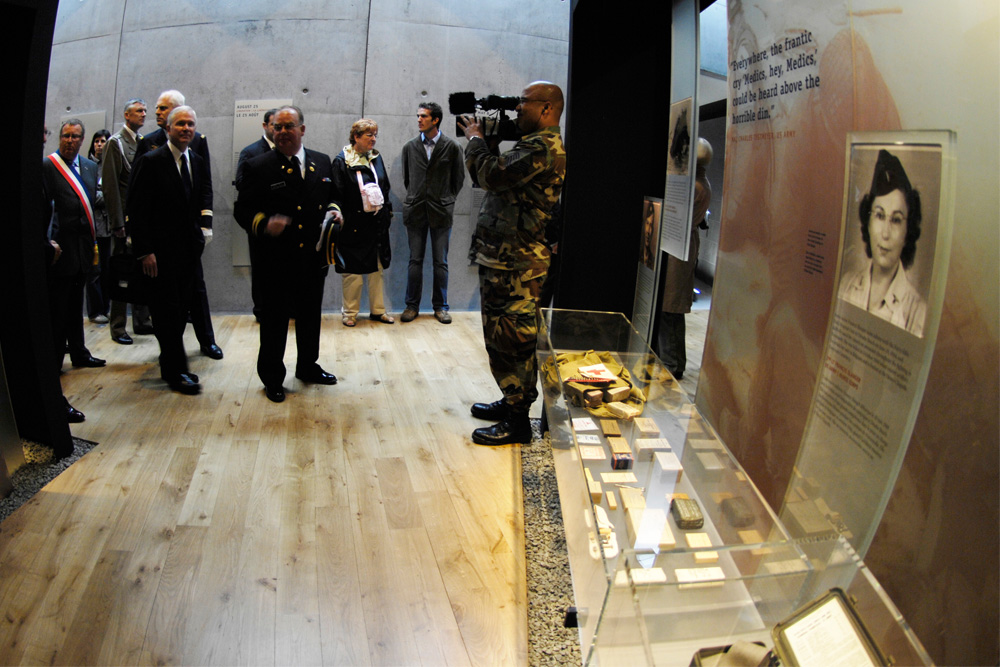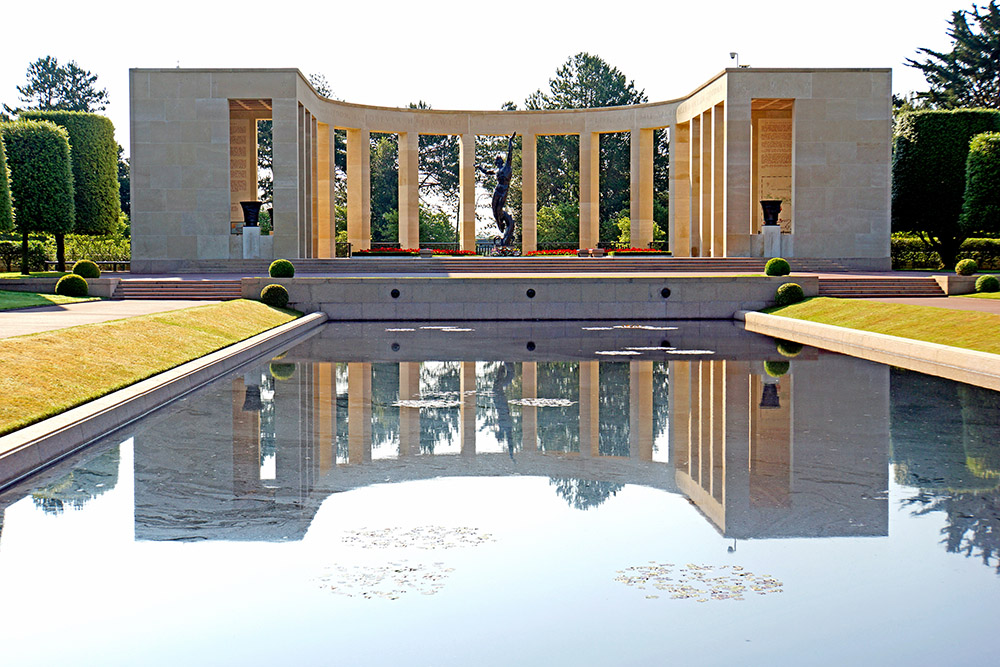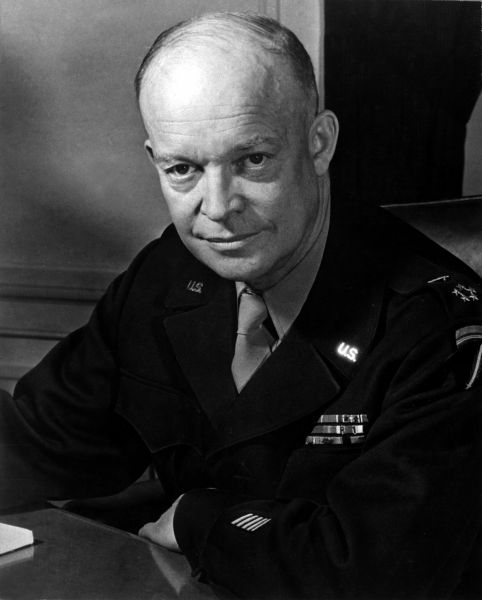Normandy American Cemetery and Memorial
General:
One of the largest American cemeteries abroad. Known worldwide for the scene in Steven Spielberg's 'Saving Private Ryan', in which veteran Ryan comes to visit the graves of Captain Miller and the other soldiers who fetched him at the time because his three brothers had died.
Description:
Overlooking the beach at Omaha Beach is the 70-acre American Cemetery of Colleville-sur-Mer. The rows of white marble crosses run endlessly and straight across the lawn. Thousands of Latin crosses with a star of David here and there. In total 9,387 memorials.
Some crosses by name and by name;
Theodore Roosevelt JR, Brigade General US Army, New York, July 12, 1944 Medal of Honor.
Next to this grave is the grave of his brother Quintin Roosevelt, who fell on July 14, 1918. It is the only grave of the First World War in the cemetery.
Other crosses have an inscription;
'Here rests in honored glory, a Comrade in Arms, known but to God' [/ i].
Experience:
Omaha Beach, 6:30 am, June 6, 1944. The invasion fleet approaches from the sea. In landing craft, the first soldiers of the 29th and 1st Division are sent to shore. No flat coast, no soft slope of sand, but a steeply ascending, overgrown dune wall where the bunkers, trenches and artillery pieces of the soldiers of 'Wiederstands Nester' 60 to 72 await. Fanatic defenders with a free field of fire. Beaches dotted with mines of all kinds, landmines, landmines attached to plane bombs, Belgian fences, anti-landing boat obstacles, iron bars lined up below the waterline to tear through the bottom of a landing boat.
Omaha Beach, noon, June 2, 2000. From the edge of the cemetery we look at the sea. The beach is down in front of us, with my camera I can take pictures of the beach from left to right for miles. There is no cover for the walkers walking along the high tide line. There was no cover for the thousands of soldiers sent to the beach at the time. 1553 soldiers are still missing. Missing in action is the American term for those who disappeared on or in the battlefield.
We walk silently between the graves.
There are two tall flagpoles on which the Stars and Stripes flutter slowly in the afternoon breeze, a golden eagle on top of the mast.
There are many people in the cemetery. But the cemetery is so big that we don't meet anyone for minutes. Many birds, the smell of the sea. The sounds of 'The Last Post' are blown on a trumpet. It makes a deep impression on us.
The engraved names of those who acquired the 'Medal of Honor' are colored in gold on their crosses. I've read a lot about D-Day, and when I come across a grave where Jimmy Monteith is resting, I know the story. Lieutenant J. Monteith, 1st Infantry Division. He came ashore with the first troops and without thinking about his own safety he organized an attack which resulted in the troops gaining strength in the relative coverage of the first dunes. He ran up and down the beach to gather more troops and led the attack on a key enemy position. On foot he led two tanks through the minefield of the beach. He died the same day when the enemy counterattacked heavily on a position captured by Jimmy Monteith.
In the center of the cemetery is a small chapel. On the wall is the text; 'I Give unto Them Eternal Life and they shall Never Perish'. The mosaic on the ceiling symbolizes America blessing her sons as they travel across the sea and through the air to fight for freedom.
The large monument at the beginning of the cemetery consists of a semicircle of columns with two walls that tell stories about the eventful month of June in 1944.
The large bronze statue in the center of the semicircle is called 'The Spirit of American Youth Rising from the Waves'.
Many wreaths have been laid.
An American 1st Division veteran stands in front of a grave. There is a small flower arrangement at his feet in front of the cross.
I would like to ask him a thousand questions, but when I stand next to him he looks at me for a moment. I shake his hand and say nothing, he says nothing.
Under a large granite slab at the entrance is a time capsule containing a message from Dwight D. Eisenhower, the supreme commander of the Allied and later President of the United States.
This message will not be opened, read and published until June 6, 2044.
I already understand the message.
As stated on the ribbons of wreaths; We shall remember them.
Do you have more information about this location? Inform us!
Source
- Text: American Battle Monuments Commission & Don van den Bogert
- Photos: Wim Hilderson (1), Jeroen Koppes (2, 3, 4, 5)
Related videos
Related books
Nearby
Museum
- Normandy American Cemetery & Memorial Visitors Centre - Colleville-sur-Mer
- Overlord Museum - Colleville-sur-Mer
- Big Red One Assault Museum - Colleville-sur-Mer
Point of interest
- Orientation Table "The Landing Beaches" - Colleville-sur-Mer
- Orientation Table Mulberry A Colleville-sur-Mer - Colleville-sur-Mer
- 25pdr SP tracked Sexton - Colleville-sur-Mer
Monument
- Memorial Chapel Normandy American Cemetery & Memorial - Colleville-sur-Mer
- American Normandy Memorial - Colleville-sur-Mer
- Memorial Provisional Engineer Special Brigade Group - Saint-Laurent-sur-Mer
Cemetery
- Commonwealth War Graves Saint-Laurent-sur-Mer - Saint-Laurent-sur-Mer
- Commonwealth War Grave Colleville-sur-Mer - Colleville-sur-Mer
- Commonwealth War Grave Sainte-Honorine-des-Pertes - Sainte-Honorine-des-Pertes






















